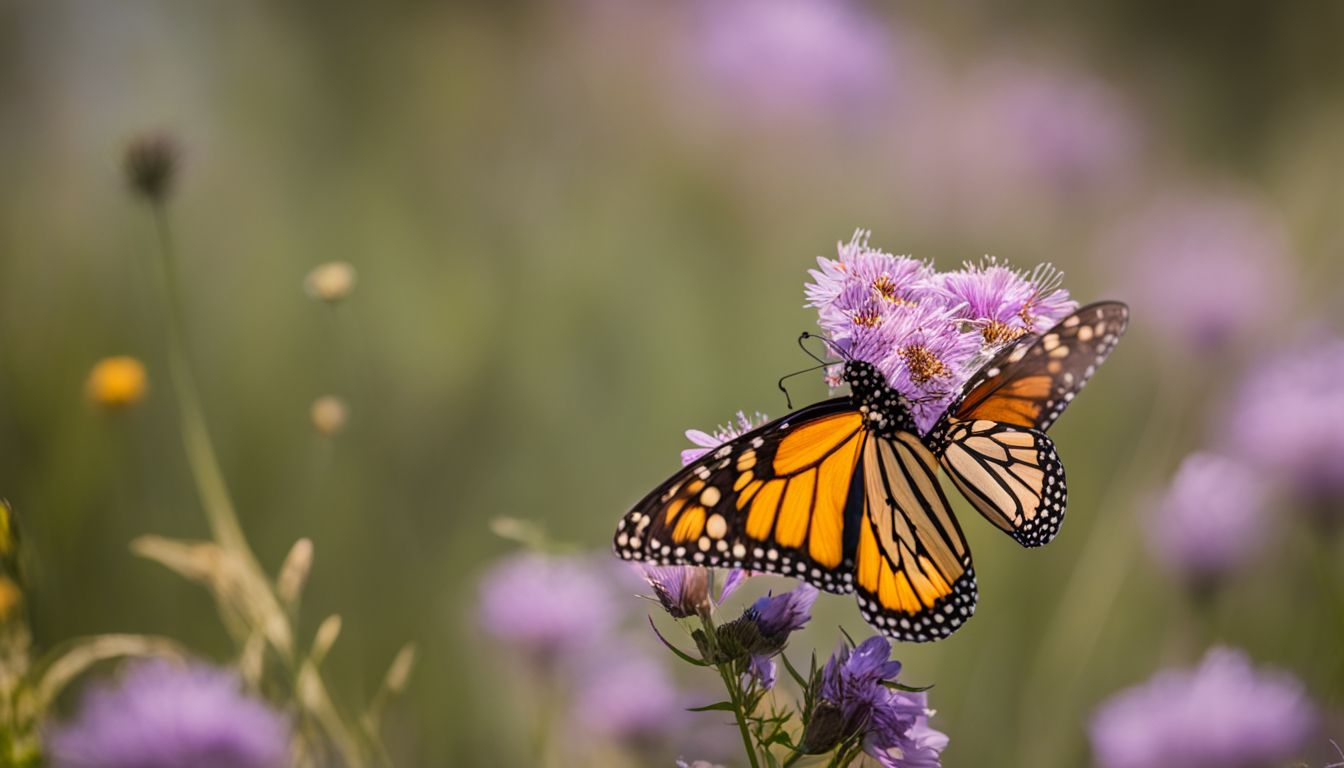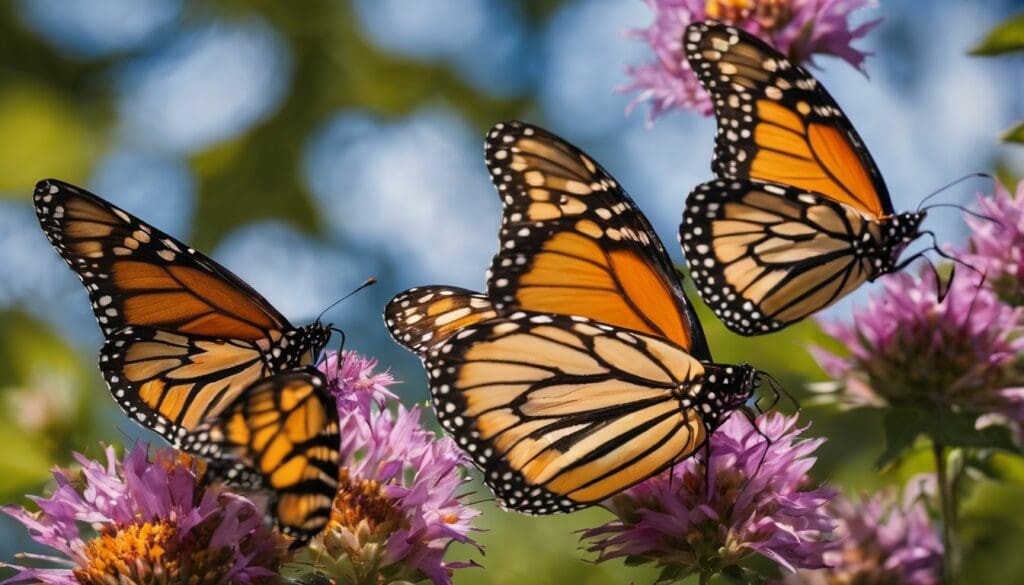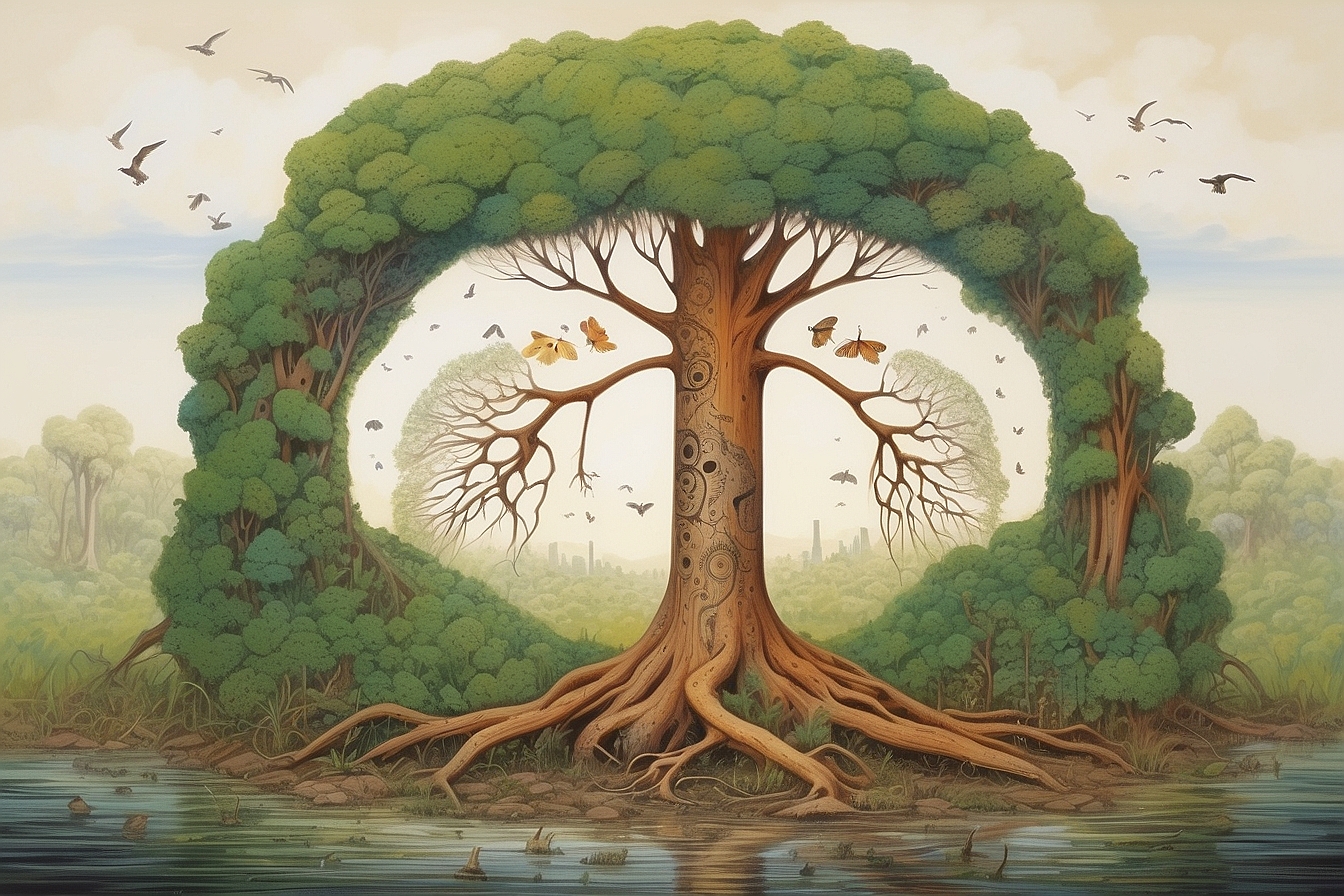Have you ever been struck by the sheer wonder of the epic journey monarch butterflies undertake each year? It’s a marvel that captures our imaginations, and with keen interest, we’ve delved into uncovering just how these fragile beauties can cover distances up to 3,000 miles.
Our forthcoming article promises to escort you step-by-step along their remarkable migration path, shedding light on the mysteries behind their stamina for such an arduous voyage. Prepare to embark on an enchanting flight alongside the monarchs – a tale of endurance bound to leave you in awe!
Key Takeaways
- Monarch butterflies embark on a migration of up to 3,000 miles from North America to overwintering sites in Mexico and California, using environmental cues like day length and temperature as signals to start their journey.
- They utilise flyways and landmarks such as peninsulas for navigation, congregating at crucial stopover sites where they can rest and refuel before reaching their destinations where they conserve energy by clustering together through cooler months.
- Milkweed is essential for the survival of monarchs as it serves as both food source and breeding ground; preserving milkweed habitats along migration routes is vital for the continuation of this species.
- Community science projects like the Monarch Monitoring Project, Monarch Watch Tagging, and the Southwest Monarch Study provide critical data on butterfly populations, migratory patterns, and help inform conservation strategies that support these pollinators across their migratory cycle.
- By participating in conservation efforts such as planting native nectar plants or avoiding pesticides, volunteers contribute significantly towards protecting these creatures throughout their lifecycle.
Understanding the Monarch Butterfly’s Migration

Delving into the monarch butterfly’s migration, we uncover a remarkable adaptation driven by seasonal shifts. This instinctive pilgrimage is guided by day length and temperature, setting in motion one of nature’s most enchanting spectacles.
The influence of seasonal changes
Seasonal changes deeply impact the monarch butterfly migration, signalling these majestic creatures when to start their journey. As temperatures drop and day length shortens in North America, Monarch butterflies prepare to travel southward.
They seek out overwintering sites amidst the oyamel fir forests of Mexico or among eucalyptus trees along the California coast.
We witness a remarkable natural event as thousands of orange and black wings beat against the cooling winds, navigating through challenging weather patterns such as snow and fog. The instinctive quest for survival drives them to find shelter where they can endure the winter months safely.
Their internal body clocks respond to environmental cues, prompting them into reproductive diapause until conditions are favourable again in spring for breeding.
The role of day length and temperature
Day length and temperature play crucial roles in triggering the monarch butterflies’ migration. As days get shorter and temperatures drop, these cues signal to monarchs that it’s time to begin their journey.
Their internal clock responds to the decreasing daylight, guiding them southward towards overwintering sites in Mexico where they’ll find milder conditions.
Monarchs rely on warm temperatures for flying; cold weather can immobilise them. So chasing warmth is a matter of survival as they navigate vast distances across North America. The perfect climate at their winter havens among the oyamel fir forests of the Transvolcanic Mountains allows them to conserve energy until spring returns.
With instincts finely tuned to nature’s calendar, monarch butterflies use environmental signals like day length and changing temperatures as launch codes for their epic migration.
This natural intuition ensures generations continue this remarkable lifecycle—it’s a constant dance with time and thermometers.
Once our mariposa monarca has readied itself, instinct guides it towards specific flyways—a testament to its incredible annual odyssey shaped by Earth’s rhythms. Now let’s explore how these majestic insects make use of landforms such as peninsulas during their migratory trek southwards.
The Journey South: Monarch Butterfly Migration

As the leaves begin to blush with autumn’s touch, monarch butterflies start an epic migration southward. They traverse vast landscapes using inherited knowledge, en route to a destination many have never seen but are instinctively drawn towards.
Use of flyways and peninsulas
We often marvel at the precision with which monarch butterflies navigate vast distances during their migration. They use well-established flyways, much like birds, taking advantage of air currents and landscapes that guide them.
These routes are like highways in the sky, stretching across North America towards warmer climates. Peninsulas play a crucial role too; they act as natural corridors directing swarms toward specific overwintering sites.
Monarch butterflies particularly favour peninsulas because they offer navigational landmarks and abundant resources for refueling along the journey. For instance, the long stretch of land along coasts provides a direct route south avoiding large water bodies that present significant obstacles for these delicate migrants.
As we continue to follow their epic voyage, we discover how essential congregation sites are to their survival during this incredible annual pilgrimage.
Congregation sites
As monarch butterflies embark on their epic journey south, they gather at specific congregation sites along the way. These locations act as critical stopovers where they rest and refuel before continuing their migration.
Imagine thousands of orange and black wings fluttering among trees; it’s a breathtaking sight! The butterflies congregate in these areas because they offer abundant nectar from flowers, protection from predators, and ideal temperatures that allow them to conserve energy.
Monarchs rely on cues from nature to find these sites year after year. It’s fascinating how they use the position of the sun in the sky and their internal clock to navigate towards these crucial habitats.
Our role is vital in preserving such areas; without them, monarchs would struggle to complete their journey. By planting native nectar plants and avoiding pesticides, we help maintain these essential congregation sites for future generations of this awe-inspiring butterfly.
Overwintering Behaviour
As we delve into the extraordinary overwintering behaviour of monarch butterflies, we uncover their remarkable strategies for surviving the cooler climates. They congregate in specific regions where they can cling to trees and remain dormant, conserving energy until spring’s warmth beckons them awake.
Overwintering sites in Mexico and California
Every autumn, monarch butterflies embark on an incredible journey to specific overwintering sites. In the mountainous forests of central Mexico, millions congregate in the Reserva de la Biosfera Mariposa Monarca.
Here, they blanket fir trees and form a living mosaic that dances with the winter light.
Our friends find similar refuge along the California coast. They cluster in coastal groves of Monterey pines and Monterey cypresses, creating a spectacle of orange and black against the evergreen backdrop.
These sanctuaries offer more than beauty; they are vital for their survival during the cold months when food is scarce, acting as natural greenhouses that maintain a stable temperature and humidity level ideal for monarchs to thrive until spring returns.
Survival strategies in cool environments
In cool environments, monarch butterflies employ remarkable survival strategies. They cluster together in masses, draping the trees to conserve warmth. Clinging onto fir and eucalyptus trees in their millions creates a living blanket that shields them from cold snaps and frosty nights.
Their body temperatures stay just high enough to survive, but low enough not to waste precious energy.
We watch as they meticulously choose their overwintering sites based on microclimates within these cool habitats. These locations are crucial for surviving winter without freezing or starving.
Monarchs rely heavily on the canopy cover to maintain a delicate balance of humidity and temperature – too much exposure could be lethal. As daylight lengthens and temperatures rise, they prepare for the next leg of their journey back northward, driven by an unerring instinct tuned over millennia.
The Return North: Multiple Generations’ Involvement
As the chill of winter recedes, a remarkable journey unfolds; generations of Monarch butterflies commence their trek northward. Crucial to this odyssey is the discovery of abundant milkweed, which serves as both nursery and buffet for their future offspring.
Importance of finding suitable milkweed
We must understand that milkweed isn’t just another plant; it’s the lifeblood for monarch caterpillars. These leafy sanctuaries are where Danaus plexippus lays its eggs, and without them, there would be no next generation to make the monumental journey across continents.
Milkweed varieties such as Asclepias curassavica serve not only as a food source but also a nursery. Here, tiny larvae transform into chrysalides before emerging as the butterflies we eagerly await each season.
Securing habitats with abundant milkweed is crucial for these migratory marvels. We see our role in habitat conservation as essential because monarch butterflies rely heavily on these plants throughout their migration cycle.
By planting native species of this vital flora along flyways or even in our backyards, we contribute to a chain of survival stations stretching from the Rocky Mountains to beyond Interstate 35.
This simple act boosts their chances against threats like habitat loss and climate change, ensuring that majestic swarms can navigate their way safely year after year.
Community Science and Monarch Migration
We play a pivotal role in deciphering the mysteries of monarch migration through our participation in community science initiatives, shedding light on their epic journey and informing conservation efforts—discover how you can contribute to this fascinating field.
Monarch Monitoring Project
- Documenting Sightings: We record every monarch butterfly spotted along their migratory routes. This data provides critical information about their travel patterns.
- Engaging Volunteers: We encourage people from all walks of life to join us in tracking migrations. This collective effort results in a wide-reaching and thorough monitoring network.
- Contributing Data: We submit our findings to databases that scientists use for research. The compiled data makes a huge difference in studying monarch populations.
- Tagging Butterflies: We carefully attach small, lightweight tags to monarch wings before they begin their journey. These tags help reveal the paths taken by individuals and the distances they cover.
- Organising Workshops: We conduct educational events to teach volunteers the correct way of tagging and monitoring without causing harm to the butterflies.
- Collaborating with Schools: Through Google Classroom and other platforms, we partner with educators to involve students in this citizen science project.
- Analysing Migration Trends: Our observations assist experts in understanding how climate change impacts monarch migration.
- Protecting Milkweed Habitats: The project underlines the importance of milkweed for monarch survival, promoting its protection and cultivation along migration paths.
- Sharing Knowledge: We provide updates and insights from our work at local seminars, online forums, and environmental workshops, spreading awareness about these majestic creatures.
Monarch Watch Tagging
Monarch Watch Tagging plays a pivotal role in understanding the migration patterns of monarch butterflies. With this programme, we contribute to vital research that informs conservation efforts.
- We attach tiny stickers to the wings of monarchs. These stickers have unique codes that allow scientists to track the butterflies’ journey.
- Volunteers carefully handle each butterfly during tagging. This ensures the safety of these delicate creatures while collecting essential data.
- Data gathered from recovered tags reveal the routes and distances travelled by these migrating lepidoptera.
- Tagging events often become community gatherings. They foster environmental stewardship and educate the public about monarch conservation.
- Schools and citizen scientists actively participate in Monarch Watch Tagging. This involvement inspires a new generation to appreciate and protect biodiversity.
- The findings from tagged monarchs assist botanists in identifying critical habitats. Protecting these areas is crucial for sustaining the species’ long-term survival.
- Our collective action through tagging programmes contributes significantly to limiting the decline of monarch populations. Every tagged butterfly adds important information to our growing body of knowledge.
- The insights gained help us understand how factors like climate change and habitat loss affect monarch migration. With this knowledge, we devise more effective conservation strategies.
Southwest Monarch Study
- We team up with the Southwest Monarch Study to track migratory patterns of monarchs across southwestern regions.
- Volunteers assist in capturing and tagging butterflies, which provides invaluable data on their journey and survival rates.
- This project focuses particularly on monarchs that breed in Arizona, Nevada, Utah, western Colorado, and New Mexico.
- We educate community members on how to identify monarchs and report sightings, bolstering citizen-led science efforts.
- Our collective observations shed light on behavioural changes possibly triggered by urban development and climate change.
- Encouraging the planting of native milkweeds is a significant part of our collaboration, aiming to boost food sources for migrating monarchs.
- We analyse collected data to recommend conservation measures that could help protect these pollinators during their migration cycle.
- By determining where monarchs choose to rest along their route, we can work to preserve these critical habitats.
Conclusion
As environmental stewards, we marvel at the monarch butterfly’s resilience and adaptability. They brave vast distances, instinctively navigating to survive and thrive. Their migration symbolises nature’s intricate connections, urging us to safeguard their pathways.
Each flutter echoes a call for conservation action from all of us. Together, let’s pledge to protect these spectacular travellers on their epic journey of survival.
FAQs
1. Why do monarch butterflies migrate?
Monarch butterflies migrate to find tropical milkweed and other bushes, which they need for feeding and laying their eggs, traveling thousands of miles for survival.
2. How far do monarchs travel during migration?
During their migration journey, some monarch butterflies cover distances similar to migratory birds, flying over the Rockies and across continents!
3. What helps monarch butterflies navigate on their long journey?
Monarch butterflies use their circadian rhythm – an internal clock that reacts to the sun’s position – along with the perception of Earth’s magnetic field and moonlight to guide them.
4. Are there differences between how monarchs and moths migrate?
Yes, unlike moths that may just fly at night using moonlight, migrating monarchs fly both day and night using a combination of sun orientation and innate muscle memory to reach their destination.





